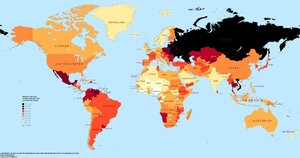Difference between revisions of "Life Expectancy"
| (8 intermediate revisions by the same user not shown) | |||
| Line 1: | Line 1: | ||
| + | [[File:F3CWFb-aEAUckt3.jpeg|thumb]] |
||
| ⚫ | Prior to the modern era women had a very high mortality rate from child birth. As a result average life expectancy of women may actually have been lower than men for much of history. Some may argue that child birth is an external factor (rather than a fundamental health factor) and so ''doesn't count''. The reality is human health is substantially affected by external factors. If one was to exclude child birth as an external factor then another could exclude the consumption of unhealthy food or the tendency for young men to engage in [[risky behaviour]]. The only reasonable way to compare life expectancy between men and women is to include all factors. |
||
| ⚫ | Prior to the modern era women had a very high mortality rate from child birth. As a result average life expectancy of women may actually have been lower than men for much of history. Some may argue that child birth is an external factor (rather than a fundamental health factor) and so ''doesn't count''. The reality is human health is substantially affected by external factors. If one was to exclude child birth as an external factor then another could exclude the consumption of unhealthy food or the tendency for young men to engage in [[risky behaviour]]. The only reasonable way to compare life expectancy between men and women is to include all factors. It was noted centuries ago, however, that women that survived their child-bearing years tended to outlive men. |
||
| ⚫ | At present women live, on average, longer than men. The gap is closing however<ref>http://www.dailymail.co.uk/news/article-2474859/Life-expectancy-gap-men-women-narrows-years.html</ref>. Men have in fact been catching up to women for decades. The reasons for this, like the difference in life expectancy itself, is complex but at least part of the reason seems to be that women are increasingly adopting activities, such as smoking and excessive |
||
| ⚫ | At present women live, on average, longer than men. The gap is closing however<ref>http://www.dailymail.co.uk/news/article-2474859/Life-expectancy-gap-men-women-narrows-years.html</ref>. Men have in fact been catching up to women for decades. The reasons for this, like the difference in life expectancy itself, is complex but at least part of the reason seems to be that women are increasingly adopting activities, such as smoking and excessive consumption of alcoholic beverages, that have been the domain of men for a very long time. Current trends suggest that men may match women for life expectancy late in the 21st century. Perhaps the current state of affairs in which women live longer than men on average will turn out to be an historical aberation. |
||
| + | |||
| + | == External Links == |
||
| + | |||
| + | * [http://www.telegraph.co.uk/men/thinking-man/five-reasons-men-finally-closing-life-expectancy-gap/ Interesting arguments on why life expectancies of men and women are converging again. They still managed to insult men though.] |
||
| + | * [https://ourworldindata.org/grapher/life-expectancy-at-age-10 Life expectancy at age 10, selected locations and times] |
||
| + | * [https://www.ncbi.nlm.nih.gov/pmc/articles/PMC2625386/ Life expectancy at age 15] |
||
| + | * [https://www.plimoth.org/sites/default/files/media/pdf/edmaterials_demographics.pdf Raising Children in the Early 17th Century: Demographics] |
||
| + | *[https://www.google.com/publicdata/explore?ds=d5bncppjof8f9_&ctype=l&strail=false&bcs=d&nselm=h&met_y=sp_dyn_le00_in&scale_y=log&ind_y=false&rdim=gender&idim=gender:1:2&ifdim=gender&tstart=-305064000000&tend=1304308800000&hl=en&dl=en&ind=false&icfg Google Public Data] |
||
| + | *[http://data.worldbank.org/indicator/SP.DYN.LE00.IN?cid=GPD_10 Average Life Expectancy By Country, The World Bank] |
||
| + | *[http://data.worldbank.org/indicator/SP.DYN.LE00.MA.IN/countries/1W?display=default Average Male Life Expectancy By Country, The World Bank] |
||
| + | *[http://data.worldbank.org/indicator/SP.DYN.LE00.FE.IN/countries/1W?display=default Average Female Life Expectancy By Country, The World Bank] |
||
== References == |
== References == |
||
| + | |||
| − | <references> |
||
| + | [[Category: Featured Articles]] |
||
| + | [[Category: Life Expectancy]] |
||
Latest revision as of 12:41, 9 August 2023
Prior to the modern era women had a very high mortality rate from child birth. As a result average life expectancy of women may actually have been lower than men for much of history. Some may argue that child birth is an external factor (rather than a fundamental health factor) and so doesn't count. The reality is human health is substantially affected by external factors. If one was to exclude child birth as an external factor then another could exclude the consumption of unhealthy food or the tendency for young men to engage in risky behaviour. The only reasonable way to compare life expectancy between men and women is to include all factors. It was noted centuries ago, however, that women that survived their child-bearing years tended to outlive men.
At present women live, on average, longer than men. The gap is closing however[1]. Men have in fact been catching up to women for decades. The reasons for this, like the difference in life expectancy itself, is complex but at least part of the reason seems to be that women are increasingly adopting activities, such as smoking and excessive consumption of alcoholic beverages, that have been the domain of men for a very long time. Current trends suggest that men may match women for life expectancy late in the 21st century. Perhaps the current state of affairs in which women live longer than men on average will turn out to be an historical aberation.
External Links
- Interesting arguments on why life expectancies of men and women are converging again. They still managed to insult men though.
- Life expectancy at age 10, selected locations and times
- Life expectancy at age 15
- Raising Children in the Early 17th Century: Demographics
- Google Public Data
- Average Life Expectancy By Country, The World Bank
- Average Male Life Expectancy By Country, The World Bank
- Average Female Life Expectancy By Country, The World Bank
